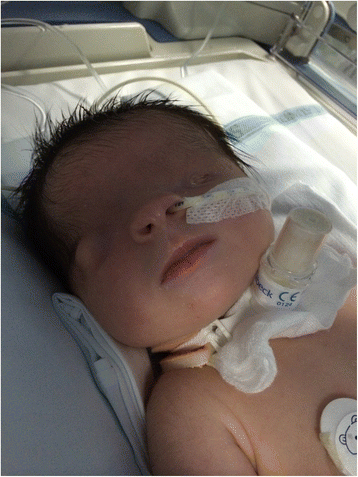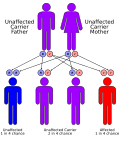Fraser syndrome

Editor-In-Chief: Prab R Tumpati, MD
Obesity, Sleep & Internal medicine
Founder, WikiMD Wellnesspedia &
W8MD's medical weight loss NYC, sleep center NYC
Philadelphia medical weight loss and Philadelphia sleep clinics
| Fraser syndrome | |
|---|---|

| |
| Synonyms | Fraser–Fraser syndrome, Meyer–Schwickerath syndrome |
| Pronounce | |
| Specialty | Medical genetics |
| Symptoms | Cryptophthalmos, syndactyly, genital anomalies, renal agenesis |
| Complications | N/A |
| Onset | Congenital |
| Duration | Lifelong |
| Types | N/A |
| Causes | Genetic mutation |
| Risks | |
| Diagnosis | Genetic testing, clinical evaluation |
| Differential diagnosis | Potter sequence, Meckel syndrome |
| Prevention | Genetic counseling |
| Treatment | Symptomatic management |
| Medication | |
| Prognosis | Variable |
| Frequency | Rare |
| Deaths | |
Fraser syndrome (also known as Meyer-Schwickerath's syndrome, Fraser-François syndrome, or Ullrich-Feichtiger syndrome) is an autosomal recessive congenital disorder.
Pathophysiology[edit]
Fraser syndrome is a rare genetic disorder characterized by partial webbing of the fingers and/or toes (partial syndactyly), kidney (renal) abnormalities, genital malformations, and/or, in some cases, complete fusion of the eyelids (cryptophthalmos) that may be associated with malformation of the eyes, causing blindness. In infants with Fraser syndrome, renal malformations may include improper development (dysplasia), underdevelopment (hypoplasia), or absence of one or both kidneys (unilateral or bilateral renal agenesis). In affected males, one or both testes may fail to descend into the scrotum (cryptorchidism), the urinary opening (meatus) may be abnormally placed on the underside of the penis (hypospadias), and/or the penis may be abnormally small (micropenis). Affected females may have malformed fallopian tubes, an abnormally enlarged clitoris (clitoromegaly), and/or an abnormally shaped uterus (bicornate uterus). In addition, the folds of skin on either side of the vaginal opening (labia) may be abnormally fused. Infants and children with Fraser syndrome may also have additional abnormalities including malformations of the middle and outer ear that may result in hearing impairment. Fraser syndrome is inherited as an autosomal recessive genetic trait.
Signs & Symptoms[edit]
Fraser syndrome is characterized by multiple physical abnormalities. These may include eye defects with complete fusion of the eyelids (cryptophthalmos), malformed or missing kidneys (renal agenesis), partial fusion of the fingers and toes (syndactyly) and middle and outer ear deformities. The nose is usually broad with a flattened bridge and deep indentations on the side of each nostril. Other characteristics may include hair growth that extends from the forehead to the eyebrows, high or cleft palate, malformation of the eyelid ducts that convey tears, a displaced navel, malformed or missing larynx, widely spaced nipples, malformation of the pubic bones and mental deficiency. Incomplete development of the genitals may be symptomatic of this syndrome. In males there may be an abnormal opening of the urethra on the underside of the penis, or failure of the testicles to descend into the scrotum (cryptorchidism). In females there may be a single or double uterus with horn-like extensions (bicornuate uterus), an enlarged clitoris (clitoromegaly), malformed fallopian tubes or a fusion of the vaginal opening (labia).
Causes[edit]
Fraser syndrome is an autosomal recessive genetic disorder. The mutant gene has been tracked to the long arm of chromosome 4 (4q21). Chromosomes, which are present in the nucleus of human cells, carry the genetic information for each individual. Human body cells normally have 46 chromosomes. Pairs of human chromosomes are numbered from 1 through 22 and the sex chromosomes are designated X and Y. Males have one X and one Y chromosome and females have two X chromosomes. Each chromosome has a short arm designated “p” and a long arm designated “q”. Chromosomes are further sub-divided into many bands that are numbered. For example, “chromosome 4q21” refers to band 21 on the long arm of chromosome 4. The numbered bands specify the location of the thousands of genes that are present on each chromosome. Genetic diseases are determined by the combination of genes for a particular trait that are on the chromosomes received from the father and the mother. Recessive genetic disorders occur when an individual inherits the same abnormal gene for the same trait from each parent. If an individual receives one normal gene and one gene for the disease, the person will be a carrier for the disease, but usually will not show symptoms. The risk for two carrier parents to both pass the defective gene and, therefore, have an affected child is 25% with each pregnancy. The risk to have a child who is a carrier like the parents is 50% with each pregnancy. The chance for a child to receive normal genes from both parents and be genetically normal for that particular trait is 25%. The risk is the same for males and females. All individuals carry a few abnormal genes. Parents who are close relatives (consanguineous) have a higher chance than unrelated parents to both carry the same abnormal gene, which increases the risk to have children with a recessive genetic disorder. Dominant genetic disorders occur when only a single copy of an abnormal gene is necessary for the appearance of the disease. The abnormal gene can be inherited from either parent, or can be the result of a new mutation (gene change) in the affected individual. The risk of passing the abnormal gene from affected parent to offspring is 50% for each pregnancy regardless of the sex of the resulting child.
Affected Populations[edit]
Fraser syndrome affects males and females in equal numbers.
Related Disorders[edit]
Symptoms of the following disorders can be similar to those of Fraser syndrome. Comparisons may be useful for a differential diagnosis: Bilateral renal agenesis is the absence of both kidneys at birth. It is a genetic disorder characterized by a failure of the kidneys to develop in a fetus. This absence of kidneys causes a deficiency of amniotic fluid in a pregnant woman. Normally the amniotic fluid acts as a cushion for the developing fetus. When there is an insufficient amount of this fluid, compression of the fetus may occur resulting in further malformations of the baby. (For more information on this disorder, choose “Bilateral Agenesis” as your search term in the Rare Disease Database.) Cat-eye syndrome (coloboma of iris-anal atresis syndrome), is a disorder which is characterized by a fissure in the iris of the eye and the absence of an anal opening. Other abnormalities may include missing kidneys (renal agenesis). Melnick-Fraser syndrome (branchio-oto-renal syndrome) is a genetic disorder characterized by hearing loss and kidney malformations, including renal agenesis.
Diagnosis[edit]
Diagnosis depends on a good family history and physical examination. Confirmation is generall. easy and is performed by means of imaging devices.
Standard Therapies[edit]
Treatment Treatment of Fraser syndrome may include surgery to correct some of the malformations associated with this disorder. Other treatment is symptomatic and supportive. Genetic counseling may be of benefit for families of children with this disorder.
Gallery[edit]
-
Fraser syndrome
-
Autosomal recessive inheritance pattern
-
Fraser syndrome CT scan
|
|
|
NIH genetic and rare disease info[edit]
Fraser syndrome is a rare disease.
| Rare and genetic diseases | ||||||
|---|---|---|---|---|---|---|
|
Rare diseases - Fraser syndrome
|
Ad. Transform your life with W8MD's Budget GLP-1 injections from $75


W8MD offers a medical weight loss program to lose weight in Philadelphia. Our physician-supervised medical weight loss provides:
- Weight loss injections in NYC (generic and brand names):
- Zepbound / Mounjaro, Wegovy / Ozempic, Saxenda
- Most insurances accepted or discounted self-pay rates. We will obtain insurance prior authorizations if needed.
- Generic GLP1 weight loss injections from $75 for the starting dose.
- Also offer prescription weight loss medications including Phentermine, Qsymia, Diethylpropion, Contrave etc.
NYC weight loss doctor appointmentsNYC weight loss doctor appointments
Start your NYC weight loss journey today at our NYC medical weight loss and Philadelphia medical weight loss clinics.
- Call 718-946-5500 to lose weight in NYC or for medical weight loss in Philadelphia 215-676-2334.
- Tags:NYC medical weight loss, Philadelphia lose weight Zepbound NYC, Budget GLP1 weight loss injections, Wegovy Philadelphia, Wegovy NYC, Philadelphia medical weight loss, Brookly weight loss and Wegovy NYC
|
WikiMD's Wellness Encyclopedia |
| Let Food Be Thy Medicine Medicine Thy Food - Hippocrates |
Medical Disclaimer: WikiMD is not a substitute for professional medical advice. The information on WikiMD is provided as an information resource only, may be incorrect, outdated or misleading, and is not to be used or relied on for any diagnostic or treatment purposes. Please consult your health care provider before making any healthcare decisions or for guidance about a specific medical condition. WikiMD expressly disclaims responsibility, and shall have no liability, for any damages, loss, injury, or liability whatsoever suffered as a result of your reliance on the information contained in this site. By visiting this site you agree to the foregoing terms and conditions, which may from time to time be changed or supplemented by WikiMD. If you do not agree to the foregoing terms and conditions, you should not enter or use this site. See full disclaimer.
Credits:Most images are courtesy of Wikimedia commons, and templates, categories Wikipedia, licensed under CC BY SA or similar.
Translate this page: - East Asian
中文,
日本,
한국어,
South Asian
हिन्दी,
தமிழ்,
తెలుగు,
Urdu,
ಕನ್ನಡ,
Southeast Asian
Indonesian,
Vietnamese,
Thai,
မြန်မာဘာသာ,
বাংলা
European
español,
Deutsch,
français,
Greek,
português do Brasil,
polski,
română,
русский,
Nederlands,
norsk,
svenska,
suomi,
Italian
Middle Eastern & African
عربى,
Turkish,
Persian,
Hebrew,
Afrikaans,
isiZulu,
Kiswahili,
Other
Bulgarian,
Hungarian,
Czech,
Swedish,
മലയാളം,
मराठी,
ਪੰਜਾਬੀ,
ગુજરાતી,
Portuguese,
Ukrainian





